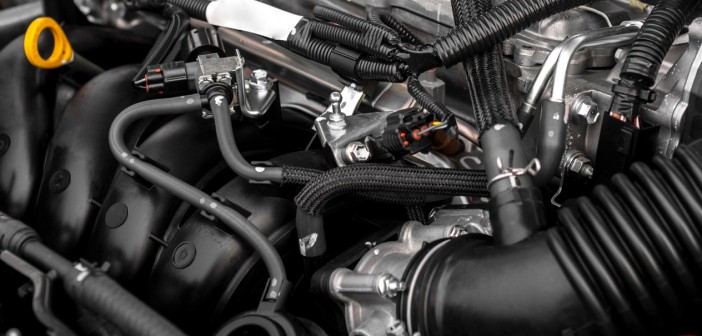Industrial rubber manufacturers provide numerous specialized automotive products formed out of rubber that has been compounded with other elements to enhance its durability, heat and cold tolerance levels, viscosity (a measurement of frictional resistance), elasticity, and other useful qualities. Silicon, for example, is added to o-rings; polyacrilic is added to rubber gaskets; and poyurethane is an additive in dust covers. These products are made more resistant to oil, grease, ozone gases, oxidation, and general degradation via these various chemical and natural additives. Natural rubber must be purified to remove small traces of other substances in the latex (polyisoprene). Artificial, or “synthetic” rubber, can be produced that is almost exactly identical to its tree-farmed cousin. Most rubber is made to undergo the process of vulcanization, wherein the latex is heated and mixed with sulfur and other ingredients. The result is a rubber more fit for use in the extreme conditions that are met with by auto parts and tires: it is longer-lasting, more “stretchable,” waterproof, and just generally tougher.
The most obvious and voluminous rubber use for automobiles is tire manufacturing. While tires were once wooden with metal, hoop-shaped rods or bands fastened around them, and the very word tire seems to derive from French blacksmith terminology, the modern inflated rubber tire has distinct benefits that led to its widespread use. First on the list of these benefits must be the protection of the wheel rim- in the old days, the metal would dig into the wood, damaging it. Second, rubber that is properly grooved will not only resist water but shed it to the side, preventing hydroplaning. The wide range of temperatures that tires endure, their gripping ability that gives you traction on the highway, and their relatively long life are all caused by or enhanced by rubber compounding practices. Carbon black and factice are common tire rubber additives which reinforce the tire’s strength. Tire beads (where the tire touches the rim) are not only reinforced by steel wiring, but use rubber that is stronger and less flexible than average to ensure the tire will not easily leak out air. The tread (the part touching the road) is of thicker and more pliable rubber. One tire company has developed a tire with a silica additive in the treads that, along with clever tread patterns, increases traction on wet roads. Sunflower oil is also added to make the tire more flexible in cold weather. Another variation in tire rubber compounding is that winter tires‘ compounds do not harden as much when temperatures fall below 45 degrees fahrenheit, maintaining grip and performance where all-weather tires begin to falter.
With more ever more powerful engines being introduced alongside long warranties and stricter emissions requirements, the pressure is on for suppliers of industrial strength rubber auto parts. Engine gaskets and seals need compounds to guarantee they work well while at high temperatures and in contact with fuels. In other words, it’s important you work with a solution provider that really knows their stuff. You can visit Eliteelastomers.com to learn more.
Some auto parts besides tires that use rubber and compounds to gain superior performance and longer use are listed below. Emission control hoses, air duct hoses, and coolant hoses all need to be made resistant to oil, heat, and ozone gases. Molded rubber products, such as power steering hoses must be both versatile and durable. The input shafts of a high-pressure hydraulic system must have power steering seals that can handle that high pressure. Those systems’ rack seals may be under 1500 psi of pressure.
Seals for diesel and gas engines, oil pan gaskets, fuel injection pump seals, and a host of other little-thought of compounded rubber auto parts are all chemically constituted for their particular tasks. Automatic transmissions are especially hard to keep sealed, but compounds and ingenious molding get it done. Engine mounts need compounds that bond rubber to metal to reduce shock impact and vibrations. Compounded rubber parts in the chassis or underside of the car absorb shocks and noisy vibrations as well to give you a smoother ride.
Rubber and compounds are in parts found all over the modern automobile- not only in the tires. Without industries well trained and equipped to provide these essential elements of a properly working car, all the rest of us would be the worse off.




